Plan your Lhasa tour? The listed top 10 attractions in Lhasa are solicited from the visitors we’ve escorted in the past. If you have more time available in Lhasa after visiting these big draw attractions, you are bestowed with many more things to do during your stay in Lhasa.
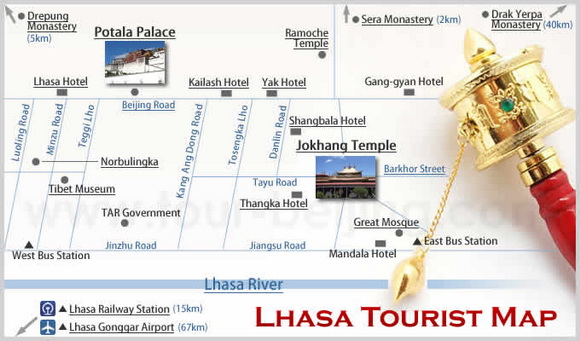
It’s always good to have some advice and recommendations from friends who have visited Lhasa.
Top 1: Potala Palace
The Potala Palace is located in the middle of Lhasa city. The name of the palace was taken from Mount Potala, the living place of the Goddess of Mercy. The palace was first built by King Songtsen Gampo in 637 for the purpose of greeting his bride Princess Wen Cheng of the Tang Dynasty in China.
During the reign of The Fifth Dalai Lama, the rebuilding of Potala Palace was started in 1645. Later the Dalai Lama and his government moved into Potala Palace in 1649. Today the Potala Palace has been turned into a museum. The Potala Palace was listed to the UNESCO World Heritage List in 1994.
Read my another article Best Places to Take Picture of Potala Palace Lhasa for more information about finding a good angle to shoot the palace.
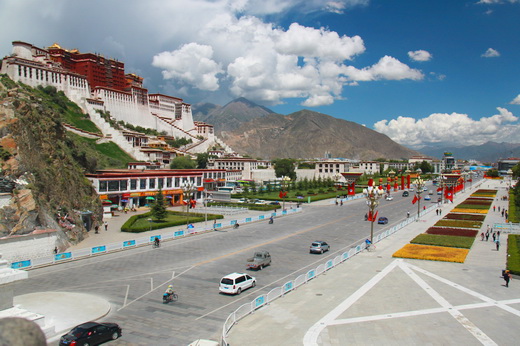
The palace is 400 metres wide from east to west and 350 metres from north to south. It has the sloping stone walls with average 3 meters thick, and 5 meters thick at the base. There are 13 stories in the palace buildings, which accommodate more than 1,000 rooms, 10,000 shrines and about 200,000 statues.
Top 2: Jokhang Temple
Jokhang Temple, the fist Buddhist temple in Tibet, is located in the center of Lhasa city. Jokhang temple was built during the reign of King Songsten Gampo to celebrate his marriage with Princess Wencheng of Chinese Tang Dynasty. For most Tibetans it is the most sacred and important temple in Tibet.
The Jokhang Temple, a massive building consisting of three floors and an open roof all filled with chapels and chambers, has undergone extensive reconstructions and additions since the 7th century.
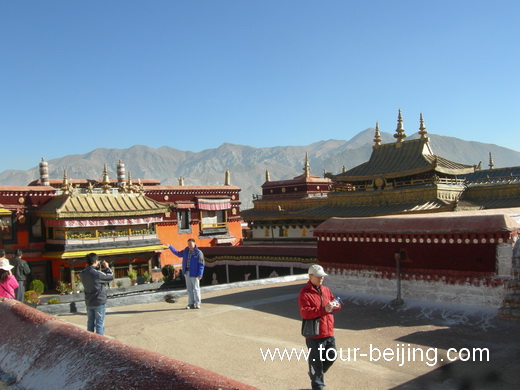
The architectural style is based on the Indian design, and was later extended resulting in a blend of Nepalese and Tang Dynasty styles. The main hall of the temple houses the Shakyamuni Buddha Statue, besides there are also famous statues of Chenresig, Padmsambhava and King Songtsan Gambo and his two famous foreign brides, Princess Wencheng of China and Princess Brikuti of Nepal.
Now it has been the most popular attraction in Lhasa and part of the UNESCO World Hentage Site “Historic Ensemble of the Potala Palace” and a spiritual center of Lhasa
Top 4: Barkhor Street
Barkhor Street is a historical and religious street surrounding Jokhang Temple and located in the downtown area of Lhasa. Barkhor Street is the most important and popular devotional kora(circuit), actually a pilgrim circumambulation.
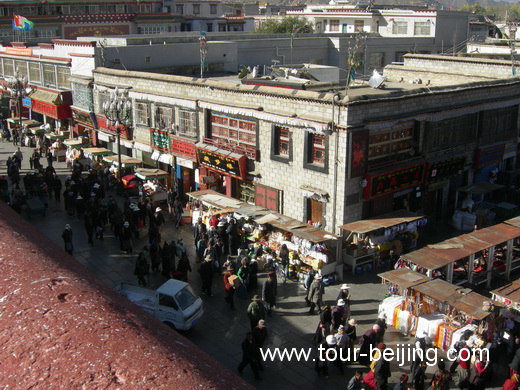
Everyday local Tibetans come all part of Tibet to pray and walk around the Jokhang Temple. Most of them come from the remote villages or mountainous areas. They come here once a year.
Top 4: Norbulingka
Norbulingka is a park-style park the west of Lhasa city. Its construction was started in 1755. It was used as a summer resort as well as administrative centre and religious centre for the successive Dalai Lamas from the 1780s till the 14th Dalai Lama’s self-exile in 1959.
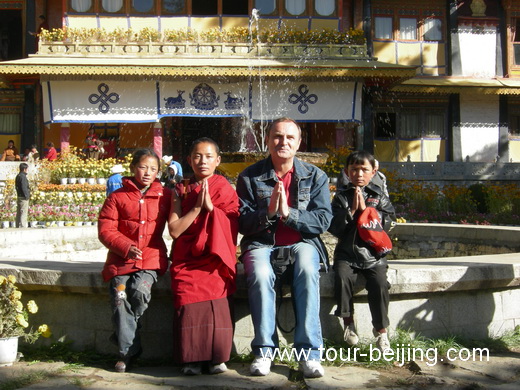
In 2001, Norbulingka is listed as a UNESCO World Heritage Site.It is a unique showcase of Tibetan palace architecture. Norbulingka park is regarded the first and best park in Tibet. Summer and autumn are at its best, becoming hubs of entertainment with dancing, singing, music and festivities.
Top 5: Namtso Lake
Namtso Lake literally means “the heavenly lake”, a mountain lake perched on the north of the Nyainqêntanglha range with a sea-level of 4,718m and a surface area of 1,920 square kilometres.
It is often quoted as the second largest salt lake (after Qinghai Lake) in China and the highest salt lake of the size in the world. Accompanied by the massive Nyainqêntanglha range, Namtso Lake appears like a charming lady, the most stunning body of water in Tibet.
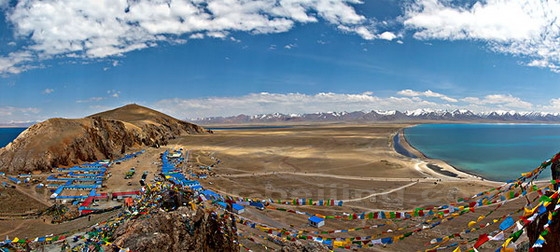
The best season to visit Namtso Lake is between June and September. Normally starting from October and November, Namtso Lake will be closed to tourists due to heavy snow. You may hire a SUV car with the help of the staffers from your hotel or inn. The cheapest way is to join in a shared coach organized by the local travel agencies.
Top 6: Sera Monastery
Sera Monastery is one of the three most important Gelukpa temple. It is located 2km north of Lhasa. The other two Gelupa temples are Ganden Monastery and Drepung Monastery.” Sera” literally means wild rose in bloom, telling the fact that the temple was built on the hill covered with wild roses.Now there are over 3,000 monks living in Sera.
See my another article Monks at Sera Je College at Sera Monastery in Lhasa for more information.

Sera is most well known for the lamas in the temple engaged in debating activity each afternoon starting from 3:000pm. The Sera Monastery is subject to the Gelugpa or Yellow Hat Sect, a branch of Tibetan Buddhism, established by Tsong Khapa.
Top 7: Drak Yerpa
In addition to including such stereotyped visits covering Potala Palace, Jokhang Temple, Sera Temple, Norbulingka and so on, don’t forget to add an excursion to Drak Yerpa Monastery, which is located about 40km northeast to the city center of Lhasa.
There are two popular Tibetan verses in relation to Drak Yerpa. One verse says that “While Tibet‘s holy place is in Lhasa, Lhasa’s holy place in Drak Yerpa”. Another verse goes like that “Visiting Lhasa without going to Drak Yerpa is just like making a new clothe without adding the collar”. These two verses pinpoint the importance of Drak Yerpa in the hearts of the common Tibetan pilgrims.
Check out my another article Drak Yerpa, My trip to Drak Yerpa Monastery for more information.
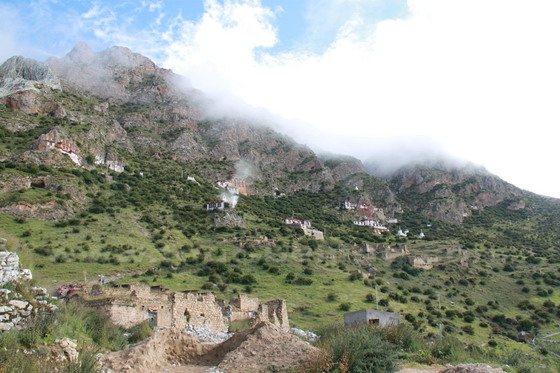
Drak Yerpa Monastery is a hermitage built on a hillside of the mountain at the altitude of 4885 meters. The hermitage is composed of many meditation caves. Some say there are now still 80 meditation left on the hillside. Some houses were built to accommodate the caves, hence cave temples. So actually Drak Yerpa is a cave monastery. Many buddhist statues in the house or the temple were caved from natural rocks.
Top 8: Tibet Museum
Tibet Museum is the provincial museum of the Tibet Autonomous Region. It is located in the west of the city of Lhasa, not far from Norbulingka and Lhasa Hotel. Its construction was completed on October 5, 1999. Tibet Museum is the first modern museum in the Tibet Autonomous Region. It has a huge collection relative to the cultural history of Tibet.
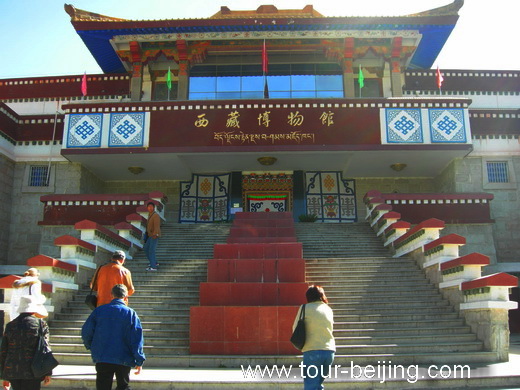
With an area of more than 53,959 square meters, Tibet Museum is mainly in Tibet style such as Tibetan doors, beam-decoration, patterns and so on, aimed at creating the atmosphere of authentic Tibetan art.
Top 9: Drepung Monastery
Drepung Monastery is located at the foot of Mount Gephel, 5km northwest of Lhasa. It is one of the three Gelukpa temples in Lhasa with the other two being Ganden Monastery and the Sera Monastery. Drepung Temple is the largest of all Tibetan monasteries.
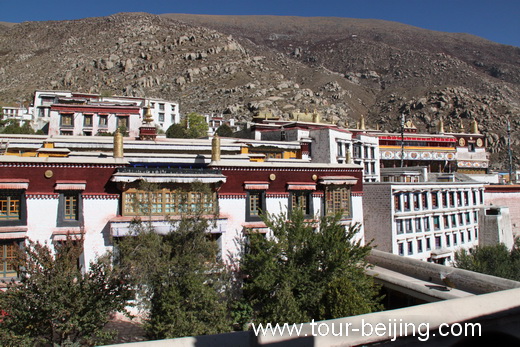
At its peak, Drepung Temple was the largest temple in the world with over 10,000 monks. The tombs of the Dalai Lamas from second to fifth are buried in Drepung Monastery.
From 1645, when the Fifth Dalai Lama founded the Potala Palace as Tibet’s political and spiritual center, the bodies of later Dalai Lamas were entombed here instead.
Top 10: Lhasa River
As you know, almost each great city in the world has a great river. Lhasa is no exception. Lhasa River, the Mother River of Lhasa is one of te five major tributaries of Yalong Tsangpo River with a total length of 551 km. Lhasa River passes the south area of Lhasa City from east to west, then runs south and meets Tsangpo River at Qushui.
Read my another article A Fun to Walk along Lhasa River in the City of Lhasa for more information.
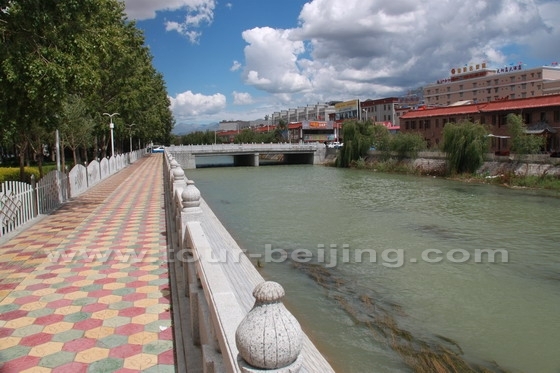
The section of Lhasa River in the city proper of Lhasa appears like a big lake nestled at the mountains in the south of Lhasa City. In the lake like river, there two islands – Sun Island and Xianzu Island. Three north to south bridges connect the downtown of Lhasa, and the two islands are linked by one bridge.
Hassle-free Lhasa Guided Tours
If you don’t want to go the do-it-yourself route and prefer the hassle-free escorted tours, here are some options for guided tours to Lhasa:
Lhasa Tour
Tibet Travel
Lhasa Tibet Group Tour
Lhasa Tibet Private Tour
Beijing Lhasa Tour
Lhasa China Tour
Further Readings
Best Time to Visit Lhasa
Top 10 Attractions in Lhasa
Lhasa Tourist Traps, Tourist Scams Lhasa
Where to stay in Lhasa
Makye Ame Lhasa Restaurant – Your Kitchen in Lhasa
Lhasa Airport, Lhasa Gonggar Airport
Xian Lhasa Flight Experience, Xian Lhasa Flight
Lhasa Railway Station Transportation, Taxi, Public Bus
Get around in Lhasa with Pedicab or Trishaw
lhasa Taxi
Best Places to Take Picture of Potala Palace Lhasa
4-Wheel Drive Trip from Lhasa to Ranwu
Tips for Visiting Drak Yerpa (Tips, Photos & Map)
The Pilgrim Kora in Lhasa, Lhasa Pilgrim circuits
How to Visit Sera Monastery in Lhasa
Beijing Road in Lhasa
Lhasa River in the City of Lhasa (Tips, Photos & Map)
Lhasa Great Mosque, the Mosques in Lhasa
Lhasa Yamdrok-Tso Lake Road Trip
Qushui Bridge in Qushui County, Tibet (Tips, Photos & Map)
Nagarzê County and Scenic Road Trip to Gyantse
Gyantse County and Road Trip to Shigatse
Shigatse Trip (Tips, Photos & Map)
Shigatse Lhatse Tingri Road Trip
Drive from Tingri to Mt.Everest Base Camp
Gangkar Town ( Gangga Town ), Tingri County
Tingri County (Tips, Photos & Maps)
Nyalam Town & Nyalam County (Tips, Photos & Maps)
Zhangmu Port & Zhangmu Town (Tips, Photos & Maps)
Any questions, just drop a line.






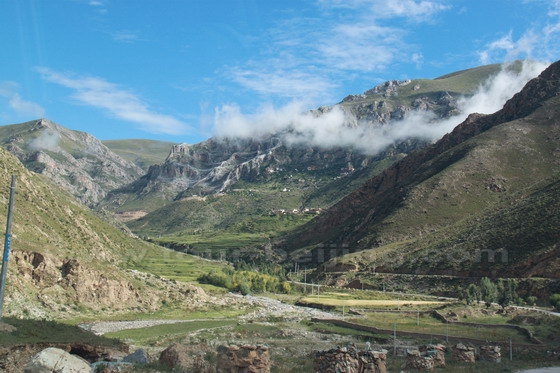
Interested in 4. Days Lhasa tour from Beijing
Await reply
Dear Jyotkumar Shah,
Thanks for your inquiry! Please check out the link below and book online:
http://www.tour-beijing.com/lhasa_tour/
Much appreciated!